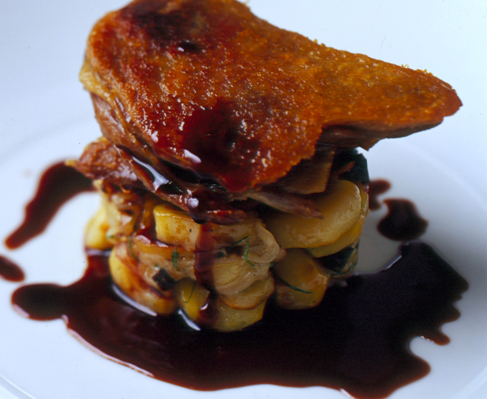News
How to make duck confit
Wednesday, November 9th, 2011
The word confit means to preserve or conserve. The process of making confit involves cooking meat very slowly in fat, until it literally falls off the bone. The most common fats used for confit are from duck, goose or chicken, which are available commercially, but chef (and man behind Chef’s Warehouse and Cookery School), Liam Tomlin, recommends making your own as it is a very simple process.
Says Liam, “I recommend confit for all poultry legs such as quail, squab, guinea fowl, pheasant, turkey or duck because they can be tough when roasted on the bone and contain a lot of sinew, which breaks down after the slow cooking process of confit. I also like to confit other meats with a low fat content such as loin of pork or rabbit.”
Rendering fat
• To make 1 litre of fat you will need to start with 2kg of raw fat available from a good butcher. Place the fat in a heavy-based saucepan with 100ml cold water to prevent the fat from sticking to the saucepan; the water will evaporate during cooking.
• Add 2 sprigs rosemary, 2 sprigs thyme, 2 crushed garlic cloves and 12 each crushed white peppercorns and coriander seeds.
• Place the fat over a very low heat and render for 6 to 8 hours.
• When the fat is crystal clear pass through a fine chinois into a stainless steel container.
• The fat can be used straight away or stored, covered in the fridge where it will solidify and can be kept for several months. When ready to use the fat, simply melt it down over a very low heat until it is crystal clear again.
Salting duck
The meat must be salted and left in the fridge for a few hours or overnight, depending on the size of the meat. Quail, squab legs and duck gizzards will only need 2 hours whilst larger cuts like duck or chicken will take 12 hours. The salt will extract any moisture in the meat, which allows the meat to be stored for several months in its fat.
To salt 2kg of meat you will need:
175g coarse salt
2g star anise
2g coriander seeds
2g white peppercorns
1 cinnamon quill
1 bay leaf
2 sprigs fresh thyme
6 garlic cloves, crushed
the rind of ½ an orange
Using a pestle and mortar, crush the salt, star anise, coriander seeds, white peppercorns and cinnamon quill. Transfer to a bowl and add the bay leaf, thyme, garlic and orange zest. Rub the salt mix into the meat and place onto a perforated tray with another tray beneath to collect any moisture released from the meat.
Cooking the confit
• Pre-heat the oven to 120 degrees C.
• Rub the salt off the legs with a clean cloth. Place the meat in a heavy-based pot and cover with rendered fat.
• Heat the fat until it just simmers.
• Cover the pot with a lid and transfer to the oven and cook until the meat is soft and comes away from the bone.
• Duck legs will take 3 to 3½ hours depending on their size and smaller pieces of meat like duck gizzards will take 45 to 60 minutes.
• It is important that the temperature of the fat stays the same during cooking. If it gets too hot, it will result in fried, stringy and dry meat.
• Remove the confit from the oven and allow the meat to sit in the fat for an hour to cool slightly. Pressing the duck confit
• Using a perforated spoon carefully lift out the confit piece-by-piece from the fat and place onto a clean tray.
• Allow the duck confit to cool sufficiently to be handled.
• Carefully remove the bones by gently twisting them. They should come away from the meat easily.
• Place the legs onto a tray with a space between each one.
• Once the tray is full, cover the duck legs with a sheet of greaseproof paper and then place another tray on top of the paper.
• Place a 5kg weight evenly across the tray to press the legs.
• Place the tray in a fridge and allow the legs to cool before removing the weight.
• When the duck legs are cold, trim-up the sides to form even-squares of duck confit. Storing confit If you’re not serving your confit immediately, you can store it in the fridge for up to six months.
• Using a perforated spoon, carefully lift out the confit from the fat, piece-by-piece, and place into a clean stainless steel or earthenware dish, gently layering the pieces on top of one another.
• Pass the fat through a fine sieve over the meat, covering it completely to form an airtight seal.
• Place the confit in the fridge where the fat will solidify and can be kept for up to 6 months.












